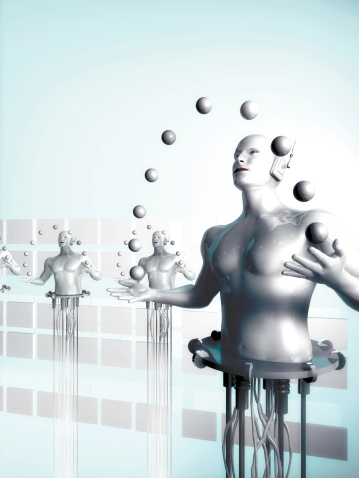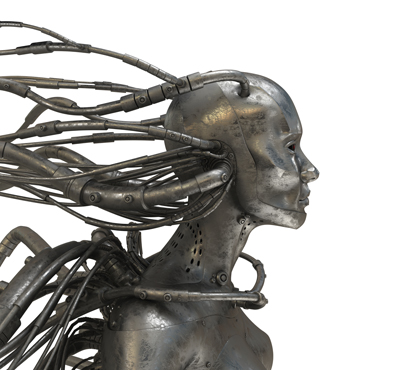
|
As noted earlier, artificial intelligence does not approximate the general, all-round capability of human intelligence. It doesn’t have the nodal capacity. And it won’t have an apparent “self” that can look at the world as a whole, form opinions about it, and make judgments—in the words of the Terminator movies, “deciding our fate in a microsecond.” Or not yet.
For now, artificial intelligences will be bound to the design of their neural nets and the universe of data sets upon which they have been trained. That is, Large Language Models like ChatGPT will play with words, grammar, syntax, and punctuation, study story forms and sentence structure, and link ideas verbally—but it won’t paint pictures or have political opinions, or at least no opinions that are not already present in its library of material. In the same way, the graphics bots that create images will play with perspective, lighting, colors, edge shapes, and pixel counts but won’t construct sentences and text. And the operations research bots, like IBM’s Watson platform, will analyze submitted databases, draw inferences and conclusions, and seek out trends and anomalies.
The difference between these machine-based writers, artists, and analysts and their human counterparts is that the machines will have access to a vastly bigger “memory” in terms of the database with which they’ve trained. Or that’s not quite right. A human writer has probably read more sentences and stories than exist in any machine database. A human painter has probably looked at and pondered more images. And a human business analyst has probably read every line in the balance sheet and every product in inventory. But human minds are busy, fallible, and subject to increasing boredom. They can’t review against a parameter and make a weighted selection from among a thousand or a million or more instances in the blink of an eye. But a robot, which never gets distracted or bored, can do that easily.
Think of artificial intelligence as computer software that both asks and answers its own questions based on inputs from humans who are not programming or software experts. For about fifty years now, we’ve had database programs that let a user set the parameters of a database search using what’s called Structured Query Language (SQL). So, “Give me the names of all of our customers who live on Maple Street.” Or, “Give me the names of all customers who bought something from our catalogue on June 11.” You need to know what you’re looking for to get a useful answer. And if you’re unsure and think your customer maybe lives on “Maplewood Road” or on “Maplehurst Court,” because you think the word “Maple” is in there somewhere, your original query would return the wrong answer.1
Artificial intelligence would be like having a super-friendly, super-fast programmer at your elbow, who can think of these alternatives, check for them, and bring you what you’re looking for. Better, it can find things in your database that might be worrisome, like a failure rate in a part that does not keep pace with previous trends. Or better, to find references in case law that you might not even have thought of, find suppliers and price breaks that you didn’t ask for, or negotiate a deal—according to strategies and set points that you as the human have determined—with other AI-derived computers at other companies.
All of this has two implications, or rather three.
First, if your company is in competition with others, and they adopt processes and business models inspired by and implemented through artificial intelligence, you would be a fool not to keep up. Their productivity in data handling will accelerate in the same way a factory that makes things is accelerated by the assembly line, robotic processes, and just-in-time inventory controls.
Second, with this “arms race” proceeding in every business, the world will speed up. Cases that attorneys used to spend days assembling will be rendered in rough draft by the office computer in seconds. Deals that once took weeks to negotiate, perhaps with one or two trips to meet face to face with your supplier or distributor, will be resolved, signed, and written into airtight contracts in under a minute. Advertising copy and artwork, the layout of the magazine, and the entire photo spread—using licensed images of the world’s top models—will be completed in under a day. The longest part of the process will be review of the machine output by the human being(s) who sign off on the end product. The business world—any world that revolves upon data and information—will move in a blur.
Third, anyone studying today in areas like communications, book publishing, graphic design, business administration, accounting, law, and certain parts of the medical delivery system had better up their game. Learn principles, not procedures or protocols. Knowledge jobs in the future will likely consist of selecting and limiting databases, setting parameters, and writing prompts for the office intelligence, rather than composing text, drawing pictures, or analyzing the database itself. The rules-following roles in business, industry, and government will quickly be taken over by machines with wider access, narrower focus, and zero distractions—not to mention no paid holidays or family leave.
Is that the singularity? I don’t know. Maybe. But it will vastly limit the opportunities in entry-level jobs for human beings who rely on rules and reasoning rather than insight and creativity. Maybe it will vastly limit the need for humans in all sorts of sit-down, desk-type jobs, in the same way that machines limited the need for humans in jobs that only required patience, muscles, stamina, and eye-hand coordination.
And maybe it will open vast new opportunities, new abilities, a step forward in human functioning. Maybe it will create a future that I, as a science fiction writer, despair of ever imagining.
That’s the thing about singularities. Until they arrive, you don’t know if they represent disaster or opportunity. You only know that they’re going to be BIG.
1. Of course, you can always throw in the wildcard symbol—the asterisk function in the American Standard Code for Information Interchange (ASCII), which is Code 42—to cover these variations. So, “Maple*” would encompass “Maplehurst” and “Maplewood” as well as “Maple-plus anything else.” But there again, it would still be best for you to be aware of those variants and plan your query accordingly.


